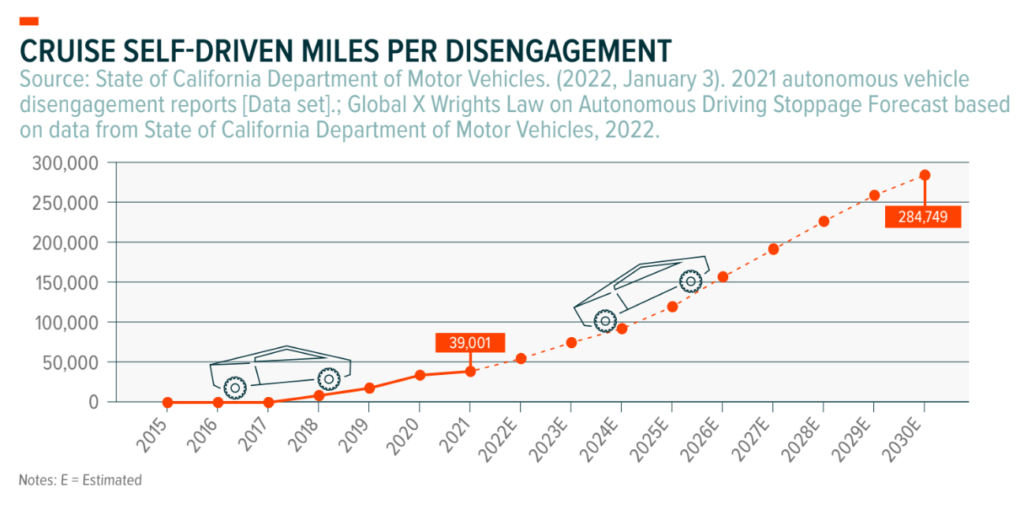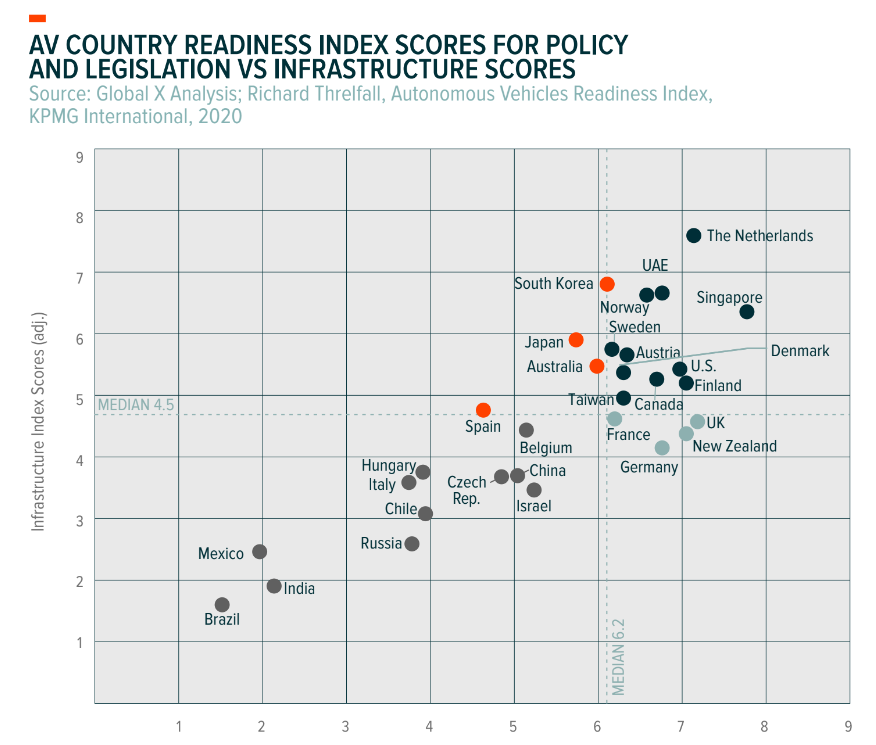Autonomous Vehicle (AV) technology has improved dramatically in recent years, supported by large investments from auto manufacturers and tech companies. Given how important expanding consumer acceptance is to AV adoption, safety is a reliable gauge of progress.
AV tech advancing, but more work remains
An AV’s ability to operate without human input depends on its level of sophistication, and can be thought of as a progression across five levels¹:
- Level 1 (Driver assistance) The driver controls most driving functions, but under certain conditions, the vehicle may be able to adjust cruise control speed or stay in a lane.
- Level 2 (Partial automation) The car can accelerate/decelerate on its own and perform basic steering functions. Driver is still responsible for directing navigation like exiting a highway, changing lanes, or turning on a new street.
- Level 3 (Conditional automation) The car can monitor the driving environment and accelerate, turn, or brake, but still expects human intervention when alerted.
- Level 4 (High automation) The car can control all driving aspects and operate without intervention, but only under certain conditions.
- Level 5 (Full automation) The car is fully autonomous and requires no human
input to operate in all driving conditions.
AV technology in the market today ranges between Levels 1 and 3, incorporating degrees of basic automation. Though fully autonomous vehicles haven’t hit the roads yet, the technology has made significant strides. AVs are collecting and processing billions of data points from an array of cameras with sensors and radar systems, which are both more sophisticated and affordable than earlier iterations. Also, advanced driver-assistance systems, including adaptive cruise control and self-parking, are now increasingly available in even low to mid-range models.
AVs use the data that they collect to continually improve the AV network’s driving skills and reduce the instances of software disengagement events and accidents. General Motors’ (GM) Cruise model currently averages more than 39,000 miles driven before triggering a disengagement event, which is a situation in which the autonomous system stops working, and requires the operator to manually take control of the vehicle to correct a potentially unsafe activity.² At current learning rates, GM’s AV technology could approach an average of 300,000 miles between disengagements by 2030 – a length exceeding the expected lifespan of a typical vehicle.³

While we are seeing progressive gains in AV safety, there is considerable room for improvement in the years ahead, as highlighted by the chart above. To collect the data needed to demonstrate better-than-human performance, AVs would need to drive approximately 275 million miles.⁴ Reaching that distance would take 100 AVs driving 24 hours a day, 365 days a year, at an average speed of 25 miles per hour for more than 10 years.⁵ ⁶ However, testing times can be reduced by combining real-world tests with “model-in-the-loop simulations.” These simulations consist of running vehicles through algorithms that cover every possible scenario to ensure that the AV system can make the right decisions.⁷
Infrastructure & policymakers play a key role
To operate effectively, AVs require high-quality roads, clear signage, and expansive data networks.⁸
In the chart below, we evaluate the “readiness” of different countries based on the conditions created by policymakers and existing infrastructure:
- Countries in the top right corner scored highest on AV infrastructure and favourable regulation, led by the Netherlands and Singapore.
- The United Sates scored well on road quality, and could be primed for improvement after the passage of landmark federal infrastructure packages in 2021 and again in 2022.⁹ ¹⁰
- Surprisingly, Israel scored poorly on AV infrastructure and regulation, despite its leading-edge tech sector.

Another challenge for the AV industry’s growth trajectory is consumer adoption as technology is actively evolving. Generally, there’s a high correlation between AV regulation and consumer acceptance, as is the case in the United States and Finland, for example. On the other hand, Japan and Austria have fairly low consumer acceptance scores relative to their performance in other areas, such as regulation, infrastructure, and innovation.
The outlook is bright
With automakers, tech companies, and suppliers across the AV supply chain investing in and advancing self-driving technology, we expect AVs will continue to become safer and more road-ready. Mass adoption will take time, but for investors interested in exposure, early commercial use cases such as robotaxis are already emerging.
AVs have the potential to revolutionise public transportation by reducing traffic congestion, the need for parking, and overall travel costs for consumers and companies alike. In our view, companies that have the technology and economies of scale in place will likely be well positioned as AV technology proliferates, having secured market share and future revenue streams.
This document is not intended to be, or does not constitute, investment research as defined by the Financial Conduct Authority.
Related ETF
DRVE: The Global X Autonomous & Electric Vehicles UCITS ETF seeks to invest in companies involved in the development of autonomous vehicle technology, electric vehicles (“EVs”), and EV components and materials. This includes companies involved in the development of autonomous vehicle software and hardware, as well as companies that produce EVs, EV components such as lithium batteries, and critical EV materials such as lithium and cobalt.
Capital at risk. The value of an investment in ETFs may go down as well as up Prospectuses and Key Investor Information Documents (KIIDs) for this ETFs is available in English at https://globalxetfs.eu/funds/drve/
¹ Car and Driver, “Path to Autonomy: Self-Driving Cars Levels 0 to 5 Explained,” Oct 2017.
² Global X Analysis of data derived from: State of California Department of Motor Vehicles. (2022, January 3). 2021 autonomous vehicle disengagement reports [Data set].
³ Ibid.
⁴ Heineke, K., Kampshoff, P., Mkrtchyan, A., & Shao, E. (2017, May 22). Self-driving car technology: When will the robots hit the road? McKinsey & Company.
⁵ Ibid.
⁶ Kalra, N., & Paddock, S. M. (2016). Driving to safety: How many miles of driving would it take to demonstrate autonomous vehicle reliability? Rand Corporation.
⁷ Heineke, K., Kampshoff, P., Mkrtchyan, A., & Shao, E. (2017, May 22). Self-driving car technology: When will the robots hit the road? McKinsey & Company.
⁸ Canis, B. (2021, April 23). Issues in autonomous vehicle testing and deployment (CRS Report No. R45985).
⁹ Schwab, K., & Zahidi, S. (2020). The global competitiveness report special edition 2020: How countries are performing on the road to recovery. World Economic Forum.
¹⁰ Kasperowicz, L., & Walker, D. (2021, October 21). The state of federal highways and bridges [2019 study]. AutoInsurance.org.
The value of an investment in ETFs may go down as well as up and past performance is not a reliable indicator of future performance.
Trading in ETFs may not be suitable for all types of investors as they carry a high degree of risk. You may lose all of your initial investment. Only speculate with money you can afford to lose. Changes in exchange rates may also cause your investment to go up or down in value. Tax treatment depends on the individual circumstances of each client and may be subject to change in the future. Please ensure that you fully understand the risks involved. If in any doubt, please seek independent financial advice. Investors should refer to the section entitled “Risk Factors” in the relevant prospectus for further details of these and other risks associated with an investment in the securities offered by the Issuer.
This communication has been approved as a financial promotion, for the purposes of section 21 of the Financial Services Market Act 2000 (FSMA), by Resolution Compliance Limited which is authorised and regulated by the Financial Conduct Authority (FRN:574048).
